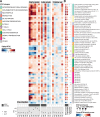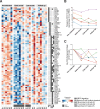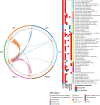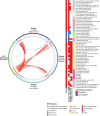Longitudinal transcriptomic characterization of the immune response to acute hepatitis C virus infection in patients with spontaneous viral clearance
- PMID: 30222771
- PMCID: PMC6160227
- DOI: 10.1371/journal.ppat.1007290
Longitudinal transcriptomic characterization of the immune response to acute hepatitis C virus infection in patients with spontaneous viral clearance
Abstract
Most individuals exposed to hepatitis C virus (HCV) become persistently infected while a minority spontaneously eliminate the virus. Although early immune events influence infection outcome, the cellular composition, molecular effectors, and timeframe of the host response active shortly after viral exposure remain incompletely understood. Employing specimens collected from people who inject drugs (PWID) with high risk of HCV exposure, we utilized RNA-Seq and blood transcriptome module (BTM) analysis to characterize immune function in peripheral blood mononuclear cells (PBMC) before, during, and after acute HCV infection resulting in spontaneous resolution. Our results provide a detailed description of innate immune programs active in peripheral blood during acute HCV infection, which include prominent type I interferon and inflammatory signatures. Innate immune gene expression rapidly returns to pre-infection levels upon viral clearance. Comparative analyses using peripheral blood gene expression profiles from other viral and vaccine studies demonstrate similarities in the immune responses to acute HCV and flaviviruses. Of note, both acute dengue virus (DENV) infection and acute HCV infection elicit similar innate antiviral signatures. However, while transient in DENV infection, this signature was sustained for many weeks in the response to HCV. These results represent the first longitudinal transcriptomic characterization of human immune function in PBMC during acute HCV infection and identify several dynamically regulated features of the complex response to natural HCV exposure.
Conflict of interest statement
The authors have declared that no competing interests exist.
Figures






Similar articles
-
Transmitted/Founder Viruses Rapidly Escape from CD8+ T Cell Responses in Acute Hepatitis C Virus Infection.J Virol. 2015 May;89(10):5478-90. doi: 10.1128/JVI.03717-14. Epub 2015 Mar 4. J Virol. 2015. PMID: 25740982 Free PMC article.
-
Maintenance of Th1 hepatitis C virus (HCV)-specific responses in individuals with acute HCV who achieve sustained virological clearance after treatment.J Gastroenterol Hepatol. 2013 Nov;28(11):1770-81. doi: 10.1111/jgh.12265. J Gastroenterol Hepatol. 2013. PMID: 23663030 Free PMC article.
-
Acute hepatitis A virus infection is associated with a limited type I interferon response and persistence of intrahepatic viral RNA.Proc Natl Acad Sci U S A. 2011 Jul 5;108(27):11223-8. doi: 10.1073/pnas.1101939108. Epub 2011 Jun 20. Proc Natl Acad Sci U S A. 2011. PMID: 21690403 Free PMC article.
-
Regulation of hepatic innate immunity by hepatitis C virus.Nat Med. 2013 Jul;19(7):879-88. doi: 10.1038/nm.3253. Nat Med. 2013. PMID: 23836238 Free PMC article. Review.
-
Acute hepatitis C virus infection.Clin Infect Dis. 2005 Jul 1;41 Suppl 1:S14-7. doi: 10.1086/429490. Clin Infect Dis. 2005. PMID: 16265608 Review.
Cited by
-
A Tale of Two Viruses: Immunological Insights Into HCV/HIV Coinfection.Front Immunol. 2021 Aug 12;12:726419. doi: 10.3389/fimmu.2021.726419. eCollection 2021. Front Immunol. 2021. PMID: 34456931 Free PMC article. Review.
-
Dual Effects of Let-7b in the Early Stage of Hepatitis C Virus Infection.J Virol. 2021 Jan 28;95(4):e01800-20. doi: 10.1128/JVI.01800-20. Print 2021 Jan 28. J Virol. 2021. PMID: 33208444 Free PMC article.
-
Dynamic and reversible transcriptomic age shifts induced by COVID-19 in Korean whole blood.Aging (Albany NY). 2025 Jun 10;17(6):1484-1510. doi: 10.18632/aging.206270. Epub 2025 Jun 10. Aging (Albany NY). 2025. PMID: 40500114 Free PMC article.
-
Differential immune transcriptomic profiles between vaccinated and resolved HCV reinfected subjects.PLoS Pathog. 2022 Nov 15;18(11):e1010968. doi: 10.1371/journal.ppat.1010968. eCollection 2022 Nov. PLoS Pathog. 2022. PMID: 36378682 Free PMC article.
-
Towards a Systems Immunology Approach to Understanding Correlates of Protective Immunity against HCV.Viruses. 2021 Sep 18;13(9):1871. doi: 10.3390/v13091871. Viruses. 2021. PMID: 34578451 Free PMC article. Review.
References
-
- Martin NK, Vickerman P, Dore GJ, Hickman M. The hepatitis C virus epidemics in key populations (including people who inject drugs, prisoners and MSM): the use of direct-acting antivirals as treatment for prevention. Curr Opin HIV AIDS. 2015;10(5):374–80. Epub 2015/08/08. 10.1097/COH.0000000000000179 ; PubMed Central PMCID: PMCPMC4659815. - DOI - PMC - PubMed
Publication types
MeSH terms
Substances
Grants and funding
LinkOut - more resources
Full Text Sources
Other Literature Sources
Medical
Molecular Biology Databases

